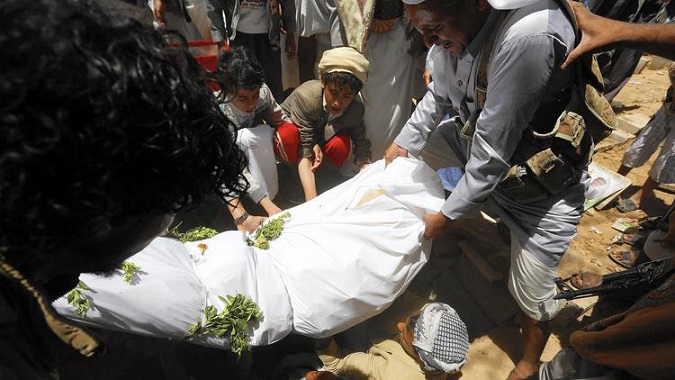Double Dealing: Saudi Airstrikes in Yemen Continue After Calling Ceasefire

After having declared an end to a month-long unprovoked bombardment in Yemen –Saudi Arabia resumed a new round airstrikes.
The US-backed coalition led by Saudi Arabia and other Gulf Cooperation Council countries, has renewed airstrikes inside Yemen, continuing their breach of international law after announcing a ceasefire and apparent end of Operation Decisive Storm.
The final phases of the Pentagon sanctioned “Operation Decisive Storm,” has given way to its sequel – another cryptic, yet cynically titled, ‘Operation Restoring Hope’, as the UN has raised concerns over civilians killed over the past four weeks.
 ‘Houthi Burial’ – Houthis bury one of their own in Sana’a, Yemen. (Photo link latimes.com)
‘Houthi Burial’ – Houthis bury one of their own in Sana’a, Yemen. (Photo link latimes.com)
With the US-Saudi proxy against the Shia militia Houthis taking center stage, Al Qaeda militants in Yemen, also known as Al Qaeda in the Arabian Peninsula or ‘AQAP’, were able to organize a jailbreak and Central Bank robbery in the midst of Western focus on the Houthis. Here’s an excerpt from a report by the LA Times that outlines the AQAP incident:
“AQAP fighters launched a jailbreak near Mukalla that freed about 300 prisoners, including several dozen of their comrades, officials and residents said.”
“The militants also stole more than $1 million in Yemeni rials from the local branch of the Central Bank, security officials said, and set up roadblocks across the city.”
This is just the latest US-sanctioned foreign policy failure to hit an already fractured region. Even the official foreign policy mouthpieces were raising alarms early on. On March 19th, in a Council on Foreign Relations (CFR) release, the rise of AQAP extremism was predicted as a symptom of the US-GCC proxy war in Yemen:
“A sectarian conflict in Yemen could help AQAP exploit the instability and expand its domestic insurgency among Sunni communities.”
While Western media has focused on the tribal fighting Houthis, AQAP, along with other Sunni militants, have suspiciously seen an unchecked rise in the region in recent years, as marked by a major prison break in 2006:
“In February 2006, twenty-three convicted terrorists escaped from a high-security prison in the capital of Sana’a, a turning point for al-Qaeda in the region. Many of the escapees worked to “resurrect al-Qaeda from the ashes (PDF)” and launch a fresh campaign of attacks. Among them was Nasser al-Wuhayshi, who today leads AQAP.”
In a New York Times report from December of 2010 entitled “Cash Flow to Terrorists Evades U.S. Efforts,” it was stated that a classified memo sent by then Secretary of State Hillary Clinton, outlined that the largest financial support for Al Qaeda linked terror operations involving Sunni extremists worldwide – has come from Saudi Arabia:
“The government cables, sent by Secretary of State Hillary Rodham Clinton and senior State Department officials, catalog a list of methods that American officials suspect terrorist financiers are using, including a brazen bank robbery in Yemen last year, kidnappings for ransom, the harvesting of drug proceeds in Afghanistan and fund-raising at religious pilgrimages to Mecca, where millions of riyals or other forms of currency change hands.”
The NY Times article continued by specifying the involvement of Saudi Arabia, United Arab Emirates, Qatar, as well as Kuwait in terror funding and logistics:
“It has been an ongoing challenge to persuade Saudi officials to treat terrorist financing emanating from Saudi Arabia as a strategic priority,” the cable said, concluding that donors in Saudi Arabia constitute the most significant source of funding to Sunni terrorist groups worldwide.”
“The dispatch and others offered similarly grim views about the United Arab Emirates (“a strategic gap” that terrorists can exploit), Qatar (“the worst in the region” on counterterrorism) and Kuwait (“a key transit point”). The cable stressed the need to “generate the political will necessary” to block money to terrorist networks — groups that she said were threatening stability in Pakistan and Afghanistan and targeting coalition soldiers.”
 ‘Yemen on Fire’ – Saudi-led airstrikes light the night sky and capital area of Yemen. (Photo link thehindu.com)
‘Yemen on Fire’ – Saudi-led airstrikes light the night sky and capital area of Yemen. (Photo link thehindu.com)
This past summer, we reported that ISIS was able to make strategic advances following Israeli air strikes on Syria. It was later revealed in the contents of a UN report that the IDF had contact with ISIS members since May of 2013.
Similarly, AQAP seems to have benefited greatly from the unprovoked military intervention in Yemen – this is something to keep a watchful eye on as the conflict in Yemen evolves.
Cross Talk’s Peter Lavelle addresses AQAP’s ‘unchecked’ growth in the wake of this crisis in Yemen…

